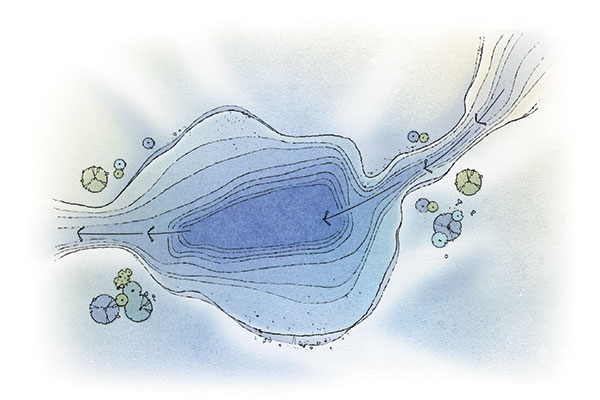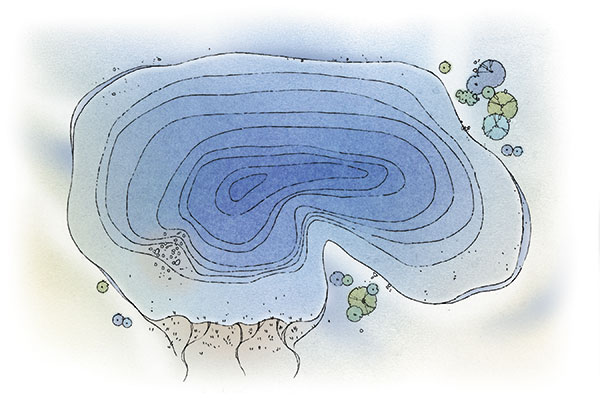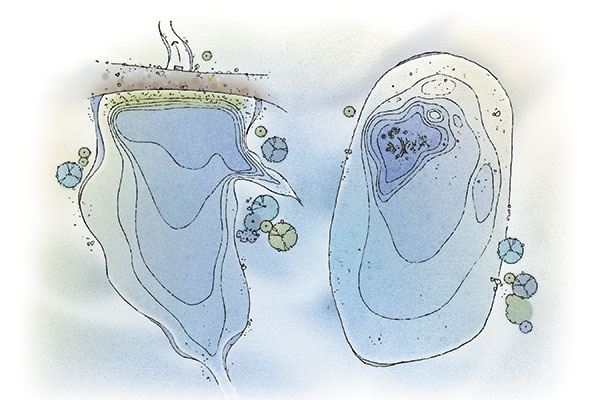Locating Big Channel Cats Under Ice
By Steve Ryan

Channel catfish are one of the more peculiar species to target through the ice. They're available in most ponds, lakes, and rivers across the ice belt. They grow big, fight hard, and taste great. Yet, only a small fraction of ice anglers pursue them. Since knowledgeable anglers have long ago debunked the myth that channel catfish hibernate in winter, and discovered that standard walleye gear can be used to catch them, locating active channel catfish appears to be the biggest challenge for anglers. That's easily solved by following a few locational tips.
River/Chain-of-Lakes SYSTEMS
Matt Johnson, a professional angler and Minnesota guide, recognizes the dynamics that channel catfish add to the ice season. When lakes enter their midwinter doldrums or his customers want a break from the usual mix of panfish and walleye, Johnson confidently puts them on some unforgettable hard-fighting catfish action.
He suggests focusing on lakes fed by river systems that are known catfish producers during the open-water season. Although he has access to local rivers with prolific catfish populations, he cautions that rivers present quickly changing ice conditions. He avoids main river channel areas when guiding customers and concentrates on lake systems with less current and safer ice.
"While rivers hold concentrated schools of feeding catfish, you need to always keep safety a priority, and a chain-of-lakes system offers more stable ice conditions," he says. "Catfish location varies among fisheries, but deep water always plays a role, especially near current or the river channel."
Deep is a relative term. In shallower waters, a small depression with a maximum depth of 10 to 12 feet can attract a large portion of the lake's catfish population. In other fisheries that offer a considerable amount of water greater than 40 feet deep, the most productive spots may be far removed from the lake's deepest waters. Instead, Johnson advises anglers to target catfish along the first break into deep water that is slightly removed from current areas. "These fish seem more active and continue to cycle throughout the area, more so than in the middle of the deep basin," he says. "I want catfish moving. Moving fish are active fish. Fish that stage over deeper areas and hunker to the bottom are less likely to bite.

"This first break in depth or deep pool adjacent to current oftentimes holds the largest schools of catfish. Focus on suspended fish. This indicates an active school. If I'm not marking fish with some space between them and the bottom, I continue searching. Do giants hold tight to the bottom? Absolutely. But when looking for an active school of biters, I look for fish that are at least a few feet off bottom or suspended higher."
Johnson says catfish remain more active than other species like largemouth bass and walleyes during post-frontal periods. "It's amazing how much catfish act like other gamefish," he says. "Most anglers think they sit on the bottom and do nothing. On the contrary, they're actively feeding. They chase and eat live minnows and other fish. They don't just eat gunk off the bottom of the lake." For this reason, he targets suspended catfish, noting that most suspended fish are located in the bottom third of the water column. These fish are much easier to coax into biting than a fish with its belly on the bottom.
A 1/16-ounce Clam Leech Flutter spoon or the 1/8-ounce Clam Jason Mitchell Rattlin' Blade Spoon are two of Johnson's favorites, fished on 6- to 8-pound monofilament. "I tip these spoons with one or more minnow heads for scent. Several larger panfish offerings get the job done as well, like the larger Clam Pro Tackle Drop-Kick and Snow Drop XL jigs packed with maggots. Otherwise, a piece of cut sucker on a circle hook set inches off the bottom on a Jason Mitchell Meatstick Rod is works great."
Natural Lakes
In natural lakes not connected to large river systems, depth continues to play a key role in locating channel cats. Deep water provides steady temperatures, visibility, and adequate oxygen. Catfish seek these stable conditions. As supported by scientific tracking studies, catfish return to their same wintering areas year after year, provided that conditions remain favorable and fishing pressure doesn't become excessive. This makes it easier to locate key deep-water holding areas. Homework is reduced in subsequent years to simply pinpointing locations holding the highest concentrations of active fish.

Since deep water remains relative from lake to lake, steep-breaking areas that drop into the main-lake basin should be examined first. This might be a break from 10 to 15 feet in moderately shallow lakes. In lakes with a substantial portion of water deeper than 25 feet, the key contour might be in the 15- to 20-foot range. On deep-basin lakes, eliminate expansive flat areas more than 40 feet deep. Such areas tend not to concentrate feeding catfish and create a "finding a needle in the haystack" situation.
With the key depth contour identified, target areas where the contour breaks quickly adjacent to a large vegetated flat. The best flats often have feeder creeks or major seepage areas that offer added oxygen and food throughout winter. Abrupt changes in contours that form underwater humps and points also are attractive. These areas offer anglers a focal area from which to cover multiple depths.
As with other gamefish, catfish use depth contours and structural elements like highways and road markers. They spend much of their resting time at the base of these contours and the flats formed by them. Channel catfish also have a strong preference for soft-bottom areas free of significant vegetation. This means eliminating hard rock bottom areas and those with dense weedgrowth. Prime spots include soft bottom areas from which bloodworms and insect larvae emerge.
Locating catfish wintering areas doesn't equate to "shooting fish in a barrel." Although key areas draw large aggregations of fish, channel cats are quite active at times, with a daily range that can span several hundred yards. Tip-ups and automatic devices spread out over large areas are great tools for locating and tracking their movement.
During low-light periods, it's not uncommon to catch large catfish on weedflats using lively golden shiners set a foot above the top of the vegetation. Catfish then transition to the outside weededge during the early morning hours prior to proceeding to the base of the deep break. Here they spend most of the day feeding in spurts. During periods of extreme high pressure, fish may slip deeper into the basin and position themselves tighter to the bottom.
Under normal conditions, a small percentage of fish in an aggregation rest almost motionlessly on the bottom. Most slowly cruise and feed within a few feet of the bottom in packs. Still others swim more quickly well off bottom or even suspend middepth in the water column. Watch your electronics and don't assume that high, quickly moving flashes aren't catfish. A good underwater camera is vital for distinguishing catfish from other species and for observing their mood.
Ponds
Catfish location in ponds depends on the type and construction of the pond. A few different types of ponds are worth examining. In many parts of the country, small impoundments are created by building an earthen dam across a creek. A spillway overflow pipe in the earthen dam regulates water level. Catfish are primarily located in the part of the pond nearest the dam. They often concentrate in the deep corners adjacent to the dam or at the next structural element closest to the dam and creek bed.
In ponds that are dug rather than dammed, catfish again look for deep water. Using an underwater camera, I've seen aggregations of catfish in many dug ponds. Good areas consistently have an uneven bottom free of dense vegetation. They tend to favor areas with some form of cover—a single tree trunk, discarded tires, or barrels that serve as a focal element. Finding these spot-on-the-spot locations can be difficult with only a flasher.

At times, 20 or more catfish can be concentrated in an area less than 6 feet in diameter. The smaller the pond or lake, the tighter catfish tend to congregate. A good underwater camera and precision in drilling holes are critical. Small compact cameras like the Aqua-Vu 5.0 Revolution Pro can be the difference between a slow day and a banner day. Previously, anglers may have failed to fully explore areas and find spot-on-the-spot locations due to dealing with older bulkier underwater cameras.
Today's compact cameras fit easily into bib pockets. The Aqua-Vu 5.0 Revolution Pro weighs mere ounces with its internal rechargeable lithium-ion battery and has a built-in cable reel on the back of the unit to retrieve and store the camera cable when hole-hopping or packing up for the day. No more hassling with an unmanageable camera cord. Since being off the mark by just 5 to 10 feet can make a big difference in catching winter channel catfish, the convenience of these new compact cameras can be a game changer.
Whether targeted in ponds, lakes, or river-fed chain-of-lake systems, locating favorable deep-water areas and then pinpointing distinctive structural elements are the first steps to catching winter channel cats. Once you find them, the real fun begins with these light-biting yet hard-fighting fish.
*In-Fisherman Field Editor Steve Ryan is an avid multispecies angler. He's appeared on In-Fisherman Television ice fishing for channel cats and has written extensively on the topic.

